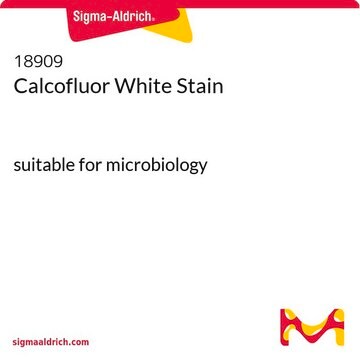910090
Fluorescent Brightener 28 disodium salt solution
used as a stain and brightening agent
Synonym(s):
Fluostain I, Calcofluor White LRP, Calcofluor White ST, Calcofluor white M2R, Tinopal LPW
About This Item
Recommended Products
form
liquid
concentration
25% in water
SMILES string
[Na+].[Na+].OCCN(CCO)c1nc(Nc2ccccc2)nc(Nc3ccc(\C=C\c4ccc(Nc5nc(Nc6ccccc6)nc(n5)N(CCO)CCO)cc4S([O-])(=O)=O)c(c3)S([O-])(=O)=O)n1
Looking for similar products? Visit Product Comparison Guide
General description
Application
- Fluorescent Brightener 28 is used in microscopy as fluorochromes, especially to visualize plant tissues by binding to cellulose.
- It is used in microbiology for staining pathogenic fungi, fungal cell walls, Candida albicans biofilms, for the automated counting of bacteria and spores, and as a viability stain.
- It is a rapid method for the detection of many yeasts and pathogenic fungi such as Microsporidium, Acanthamoeba, Pneumocystis, Naegleria, and Balamuthia species.
- It is used industrially as a fluorescent brightening agent for cellulose and polyamide fabrics, paper, detergents, and soaps.
- It has been used in the identification and study of the structure and biosynthesis of chitin from the freshwater sponge Spongilla lacustris, and to elucidate the location of chitin in skeletal structures.
Biochem/physiol Actions
Features and Benefits
- Facilitates rapid detection of many pathogenic yeasts and fungi.
- As a brightening agent, its addition can offset the tendency of white materials to yellow with age.
Storage Class
12 - Non Combustible Liquids
wgk_germany
WGK 1
flash_point_f
Not applicable
flash_point_c
Not applicable
Choose from one of the most recent versions:
Certificates of Analysis (COA)
Don't see the Right Version?
If you require a particular version, you can look up a specific certificate by the Lot or Batch number.
Already Own This Product?
Find documentation for the products that you have recently purchased in the Document Library.
Our team of scientists has experience in all areas of research including Life Science, Material Science, Chemical Synthesis, Chromatography, Analytical and many others.
Contact Technical Service








